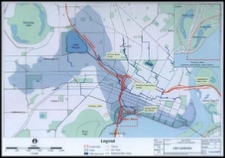
Working to conserve and restore water quality and wildlife habitat in Perth inner city catchments
Water quality in the Mounts Bay Catchment
The Mounts Bay Drain is part of a drainage system which connects Lake Monger to the Swan River at Mounts Bay, in front of Perth city. The Mounts Bay Drain was constructed in 1909 to allow water levels in Lake Monger to be regulated. Prior to this, Lake Monger was part of the chain of lakes north of the city which were interconnected during the wet season and drained into the river through Claise Brook. Overflow from Lake Monger, flows via the Mounts Bay Main Drain (MBMD), discharging into the Swan River at Mounts Bay through an outlet west of Barrack Square.
The Claise Brook Catchment Group has been concerned for some years about water quality within this catchment and within the receiving waters which is the Swan River and particularly Mounts Bay.
Due to the urbanisation of the catchment and other reasons, the water quality is poor and pollutants tend to get trapped in Mounts Bay which is poorly flushed by tides or river flow. Water quality is also of concern in the water bodies within the catchment including the lakes within the Narrows Interchange which are an important recreational area for visitors to the city as well as the increasing number of city residents.
The area between Lake Monger and the Swan River has been highly modified since 1829. Firstly the wetlands were used for market gardens, then the railway line was built (opened 1880) and Perth’s first industries developed along the railway line before drainage and sewerage were extended through the area. More recently the Narrows Bridge was built, followed by the freeway and the Narrows and Hamilton Interchanges which required additional drainage. Most recently the Northbridge tunnel was constructed and the Perth Mandurah railway, which passes through the narrows interchange, was recently completed.
Future development of the river foreshore in the Narrows Interchange area is proposed and the catchment group considers it important that water quality problems are addressed as part of any future development within this catchment.
Many managers
There are many Stakeholders in the MBMD system. The MBMD is a declared main drain and is owned and operated by the Water Corporation. In the upper catchment the City of Subiaco manages Mabel Talbot Lake, which feeds into Lake Monger. The Town of Cambridge manages Lake Monger and controls the outlet weir which allows water to enter the MBMD from Lake Monger. The Hamilton Lakes and Narrows Interchange Lakes and associated pumps and pipes are managed by the Main Roads Department with the City of Perth. The City of Perth manages the Narrows Interchange area as parkland for passive recreation and tourism purposes and water from one of the lakes is used to irrigate the parkland.
The Swan River Trust is working to reduce nutrient and pollutant inputs to the river and improve water quality as well as foreshore habitat through a number of programs. The Narrows Interchange area and the outlet from the MBMD are located within the Swan River Trust Development Control Area. The Department of Water provides technical advice and policy direction for stormwater management.
Perth Region NRM is the regional natural resource management group and are interested in ensuring that the relevant stakeholders are involved in resource management issues. They are working with light industry and local governments to reduce pollutants from this activity.
The Claise Brook Catchment Group is the local catchment group with an interest in this area. We are primarily concerned with water quality and habitat and the better connection of people with their urban ecosystems. With our local knowledge of the area we are able to provide a community perspective to the project.
Improving water quality
In May 2006 the Claise Brook Catchment Group brought together many of the stakeholders mentioned above to discuss the issues and identify whether proposed future works in the area provide opportunities to implement changes which could improve water quality within the catchment. All Stakeholders affirmed that they are concerned with water quality and recognise the need to make some improvements to the system to improve the water quality in the lakes and entering the Swan River.
Download the Report of the 4th May 2006 workshop here.
Subsequent workshops were held to assist in the preparation of a Water Quality Improvement Plan (WQIP) which was completed in September 2009. The WQIP is supported by the Swan River Trust through the Healthy Rivers Action Plan to provide local councils and communities with guidance to improve water quality in their catchment. Download the Mounts Bay Catchment WQIP here.
The catchment group is continuing to liaise with stakeholders within this catchment to identify ways of improving water quality in this catchment as the area becomes a vibrant community connecting the city to the river. Through the development of a Memorandum of Understanding the key stakeholders are committed to working together to implement actions of the Mounts Bay Catchment WQIP.
Click to download the Water Quality Improvement Plan.

Mounts Bay, early 1900s

Filling in Mounts Bay for the Narrows Interchange, 1960s

Mounts Bay Catchment. Click on map to download larger size.
Perth Waterfront - click to open webpage.

